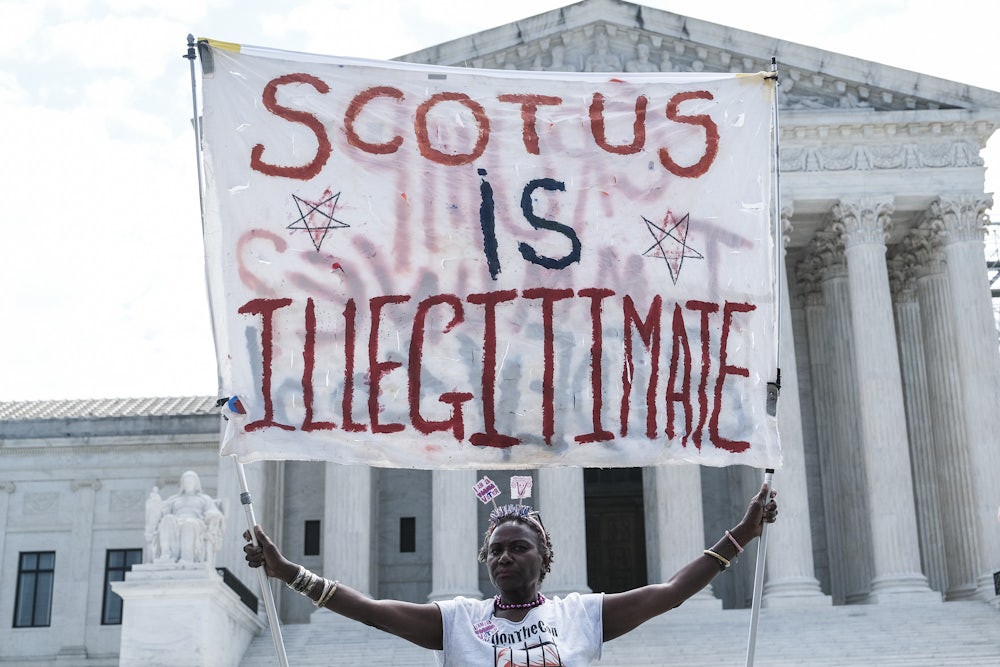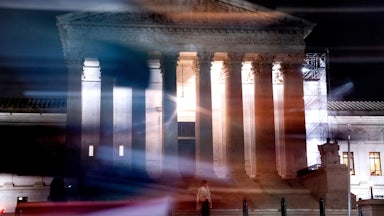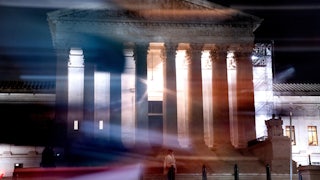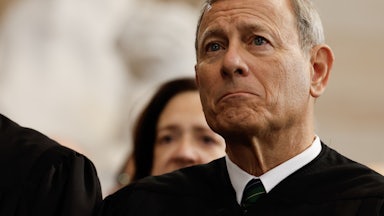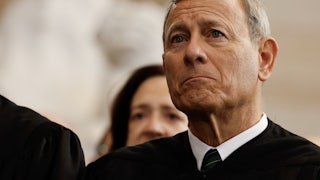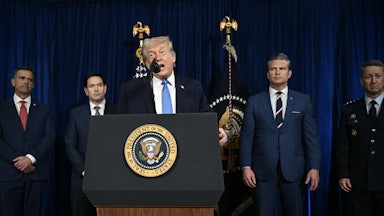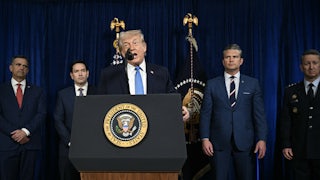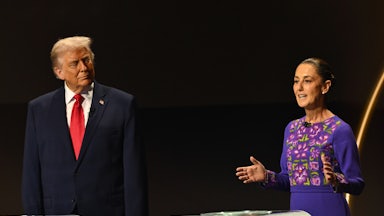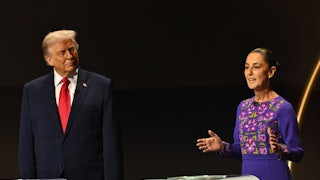The Supreme Court’s most recent term may be over, but its work on behalf of President Donald Trump continues. The justices announced on Wednesday evening in Trump v. Boyle that they would stay a lower court order that had blocked Trump from firing the three Democratic appointees on the Consumer Product Safety Commission.
As usual, the court’s action took place on the shadow docket, where it handles emergency appeals and motions. This time, the court’s conservative majority greatly expanded that docket’s power to decide legal and constitutional questions. In theory, shadow-docket actions are procedural or administrative in nature and shouldn’t be seen as a decision on the actual merits of a case.
That understanding no longer holds weight. Trump’s dismissals violated a federal statute passed by Congress that only allows the president to fire CPSC commissioners for cause. The Supreme Court previously ruled in the 1934 case Humphrey’s Executor v. United States that Congress could lawfully extend for-cause removal protections to the heads of certain agencies. Congress has not repealed the law in question. The Supreme Court also has not overturned Humphrey’s Executor outright.
Except, well, now it effectively has. “Although our interim orders are not conclusive as to the merits, they inform how a court should exercise its equitable discretion in like cases,” the court wrote in its unsigned order. “The stay we issued in [Trump v.] Wilcox reflected ‘our judgment that the government faces greater risk of harm from an order allowing a removed officer to continue exercising the executive power than a wrongfully removed officer faces from being unable to perform her statutory duty.’”
You morons, the court might as well have said to lower court judges. Why are you applying our precedents to these cases? Why aren’t you telepathically discerning the law of the land from these unsigned orders where we barely explain ourselves? Why aren’t you treating our procedural moves as equivalent to a fully briefed decision on the merits? Don’t you know we want Humphrey’s Executor dead and buried?
Justice Brett Kavanaugh, for his part, was the only member of the majority with a somewhat intellectually consistent position on how to handle this case. He argued in a concurring opinion that, in addition to issuing a stay, the court should have simultaneously agreed to take up the case on the merits because the case centered on whether one of the high court’s precedents should be overturned.
“In those unusual circumstances, if we grant a stay but do not also grant certiorari before judgment, we may leave the lower courts and affected parties with extended uncertainty and confusion about the status of the precedent in question,” he argued. (Certiorari before judgment is a rarely used procedure where the court reviews a district court’s ruling without waiting for an appeals court to weigh in.) He noted that waiting for the issue to “percolate” in the lower courts made no sense because lower courts, by definition, cannot overturn a Supreme Court ruling.
Justice Elena Kagan noted in a short but stern dissent that the conservatives had wrought major changes to the structure of the federal government with only a cursory explanation. “The majority’s sole professed basis for today’s stay order is its prior stay order in Wilcox,” she wrote, referring to the court’s prior decision in May to allow Trump to dismiss members of the National Labor Relations Board. “But Wilcox itself was minimally (and, as I have previously shown, poorly) explained.”
The three-sentence explanation the court gave in Wilcox, Kagan argued, was insufficient to justify Wednesday’s order. “So only another under-reasoned emergency order undergirds today’s,” she continued. “Next time, though, the majority will have two (if still under-reasoned) orders to cite.” At that point, Kagan noted, the court’s reasoning would be “turtles all the way down.” (Kagan also wrote the dissent in the Wilcox case; she appears to be the liberal justices’ point person on this issue.)
The immediate impact of Wednesday’s order is that Trump will be able to dismantle the Consumer Product Safety Commission, which will, in turn, make it easier for companies to keep unsafe and dangerous products on the market. This is not a good thing for Americans, of course, but it is a great boon to those companies that want Americans to keep buying their unsafe and dangerous products. In the longer term, Wednesday’s ruling is a further sign of how the Supreme Court is getting worse during Trump’s second term: more lawless, more arbitrary, less judicial, and less respectable.
Here is how the federal government has generally worked within living memory. Congress generally passes laws to provide the scaffolding for federal agencies to regulate the national economy. In theory, Congress could pass a new law every time it wants to approve a cancer drug, or ban a pesticide, or do any of the other mundane but vital tasks that come with governing a modern industrialized economy. Instead, it created agencies to regulate these things within the bounds that Congress authorizes.
Most of these agencies operate directly under the president. Starting in the early twentieth century, Congress also began to create agencies like the Federal Trade Commission and the Securities and Exchange Commission to tackle more complex economic issues, investing them with a greater degree of power and autonomy. Presidents have the power to appoint the heads of these agencies, as the Constitution requires, but Congress set limits on when and how they can fire them to give those agencies a measure of independence.
The first real legal test of these limits came in 1933 when the newly elected President Franklin D. Roosevelt fired William Humphrey, one of the FTC commissioners appointed by Calvin Coolidge, over his qualms about the New Deal. Humphrey died of a stroke in early 1934, and the executor of his estate sued the federal government over his salary. If Humphrey’s firing was illegal, the estate would have a claim on the money that the government owed to him.
The Supreme Court unanimously sided with Humphrey’s estate—a striking result given the court’s later divides over the constitutionality of the New Deal. The court limited Myers v. United States, a 1927 ruling where then–Chief Justice William Howard Taft suggested a much broader removal power for the president, and held that because the FTC and similar agencies exercised “quasi-legislative” and “quasi-judicial” powers, Congress could limit the executive branch’s power over them.
This worked out pretty well for the United States, which enjoyed a high standard of living and unprecedented economic prosperity throughout the twentieth century. You would not know this if you only listened to the conservative legal movement, which often describes these agencies and their powers in ominous and near-apocalyptic terms. In a 2020 case, for example, Justice Clarence Thomas claimed in a concurring opinion that “the decision in Humphrey’s Executor poses a direct threat to our constitutional structure and, as a result, the liberty of the American people.”
Humphrey’s Executor was 85 years old at that point, and the republic somehow managed to survive until then. It would be more accurate to say that the precedent was a threat to corporate interests since it preserved the independence of their regulators from political interference. (The court often gets these things confused.) Selia Law v. Consumer Financial Protection Bureau, the case in which Thomas wrote that concurring opinion, narrowed Humphrey’s Executor by allowing Trump to fire the CFPB’s director. That decision, in turn, paved the way for the Trump administration to dismantle the agency altogether when it retook power earlier this year.
At the center of the court’s approach to these agencies is a fundamental misunderstanding about the separation of powers and the early republic. In his majority opinion in Selia Law, Roberts explained the Framers’ mindset through his own hyper-presidentialism. He sketched a vision of the Constitution where Congress was a potential fount of despotism and the presidency was the bulwark of American democracy.
“The Framers viewed the legislative power as a special threat to individual liberty, so they divided that power to ensure that ‘differences of opinion’ and the ‘jarrings of parties’ would ‘promote deliberation and circumspection’ and ‘check excesses in the majority,’” he wrote, quoting from the Federalist Papers. “By contrast, the Framers thought it necessary to secure the authority of the Executive so that he could carry out his unique responsibilities. As Madison put it, while ‘the weight of the legislative authority requires that it should be … divided, the weakness of the executive may require, on the other hand, that it should be fortified.’”
“The Framers deemed an energetic executive essential to ‘the protection of the community against foreign attacks,’ ‘the steady administration of the laws,’ ‘the protection of property,’ and ‘the security of liberty,’” Roberts continued, quoting again from various parts of the Federalist Papers. “Accordingly, they chose not to bog the Executive down with the ‘habitual feebleness and dilatoriness’ that comes with a ‘diversity of views and opinions.’ Instead, they gave the Executive the ‘[d]ecision, activity, secrecy, and dispatch’ that ‘characterise the proceedings of one man.’”
I do not doubt that the Framers intended the presidency to be a potent and vital branch of government. But Roberts’s understanding of the founding era is impossible to square with even a modicum of historical context. The Framers did not write the Constitution in a vacuum; they gathered for the express purpose of fixing the flaws in the Articles of Confederation. Under the Articles, there was no president and no national system of courts, and its legislature had few powers that could only be exercised unanimously.
The Constitution, by its very nature, created a far more powerful executive and judiciary than what existed under the Articles. Something is always infinitely greater than nothing. Far from weakening the legislative branch, the Framers made it a substantially more powerful institution than its predecessor under the Articles or the revolutionary-era Continental Congress. They imbued it with the power to tax and regulate interstate commerce. They transferred to it the states’ powers over trade, copyright, naturalization, and diplomacy with Native American nations. It has the power to create and destroy any federal court other than the Supreme Court, and it can limit even the high court’s jurisdiction to a significant degree.
Congress can remove any executive or judicial officer from power with a majority vote in one chamber and a two-thirds vote in the other, while the president and the courts cannot remove a single senator or representative from their duly elected office for any reason whatsoever. It can disband and defund the president’s armies and agencies at will. It could add a hundred justices to the Supreme Court on a whim. All of these powers are just the explicit, undisputed ones at its command. If the Framers actually thought the legislative branch was a “unique threat to individual liberty,” they didn’t show it when they actually wrote the Constitution.
I digress slightly. Even against this backdrop, Roberts refused to kill Humphrey’s Executor altogether. He distinguished between the CFPB, which had a single director, and agencies like the FTC or the SEC that had a single multimember commission. Whether that conclusion is consistent with historical practice is debatable, as Kagan noted in her dissent in that case, but at least it is an intelligible legal and constitutional argument.
Now the court has abandoned such things. Its apparent goal is to destroy (or, as in these particular cases, make it easier for other constitutional actors to destroy) federal regulatory agencies as they have existed for nearly every American’s lifetime. It does not care that Congress has created them or that presidents signed them into law; it refuses to even acknowledge the elected branches’ real interests here. In Wednesday’s order, as I mentioned earlier, the majority explained that it thought “the government faces greater risk of harm from an order allowing a removed officer to continue exercising the executive power than a wrongfully removed officer faces from being unable to perform her statutory duty.”
Kagan noted in her Wilcox dissent that this framing got the issue exactly and deliberately wrong. “On the latter side, the relevant interest is not the ‘wrongfully removed officers,’ but rather Congress’s and, more broadly, the public’s,” she explained, referring to the two fired NLRB appointees. “What matters, in other words, is not that Wilcox and Harris would love to keep serving in their nifty jobs. What matters instead is that Congress provided for them to serve their full terms, protected from a president’s desire to substitute his political allies.”
Nothing sums up how hackish and unjudicial the court’s approach has been more than its Federal Reserve exception in Wilcox. Many court-watchers had thought, especially after Selia Law, that the Supreme Court’s current roster would not overturn Humphrey’s Executor in its entirety, in large part because there would be no way to logically maintain the for-cause protection for the Federal Reserve Board of Governors if it did. Few things could more fundamentally disrupt and weaken American capital markets—and, by extension, the American economy—than giving a president direct control over the Fed’s monetary levers. Imagine if Trump could set interest rates like he sets tariff rates.
The NLRB members warned as much in their filings in the Wilcox case. So the conservative majority squared the circle by declaring, almost by fiat, that its implied overruling of Humphrey’s Executor did not apply to the Federal Reserve. “The Federal Reserve is a uniquely structured, quasi-private entity that follows in the distinct historical tradition of the First and Second Banks of the United States,” the court’s unsigned order said without further elaboration. Its sole legal citation for this point was a footnote in Selia Law where the court had assumed, purely for the sake of argument in response to a dissent, that the Fed could claim a “special historical status.”
This is one step above simply writing, “Why? Because the court said so, that’s why.” Kagan could barely contain her disgust in her Wilcox dissent. “And so an assumption made to humor a dissent gets turned into some kind of holding,” she wrote. “Because one way of making new law on the emergency docket (the deprecation of Humphrey’s) turns out to require yet another (the creation of a bespoke Federal Reserve exception). If the idea is to reassure the markets, a simpler—and more judicial—approach would have been to deny the President’s application for a stay on the continued authority of Humphrey’s.”
All of this represents a fundamental shift in how the Supreme Court operates. The court could have allowed the CPSC and NLRB officials to stay in office to preserve the status quo during litigation, heard their cases on an accelerated briefing schedule, and overturned Humphrey’s Executor while ruling against them on the merits. The court’s critics could have disagreed with the court’s ultimate reasoning, but they could have found no fault in how it operated to get there. Instead, the conservative justices simply did what they wanted to do because they could.
What a dizzying sensation that will be for any American raised in our civic faith. Covering the court for the last six months feels less like covering a court of law steeped in the Anglo-American legal tradition and more like covering the Soviet Union’s politburo or Iran’s Guardian Council from afar. The Supreme Court’s most impactful work this year has not been to decide actual cases and controversies on the merits, or to fairly balance the equities on shadow-docket questions, but to enforce a certain ideological vision upon the American constitutional order as quickly, as bluntly, and as hackishly as it can.
I do not write lightly that the central theme coming from the Supreme Court as of late is that Trump’s own vision for the country supersedes the laws that Congress has actually written—to provide for-cause removal protections, to create a Department of Education, to provide anti-torture protections for prospective deportees, and so on. As Humphrey’s Executor’s fate shows, that vision might even outrank the decisions of the high court itself when the justices agree with it. That raises an unsettling question: If the justices don’t respect their own precedents or procedures, why should anyone else?
